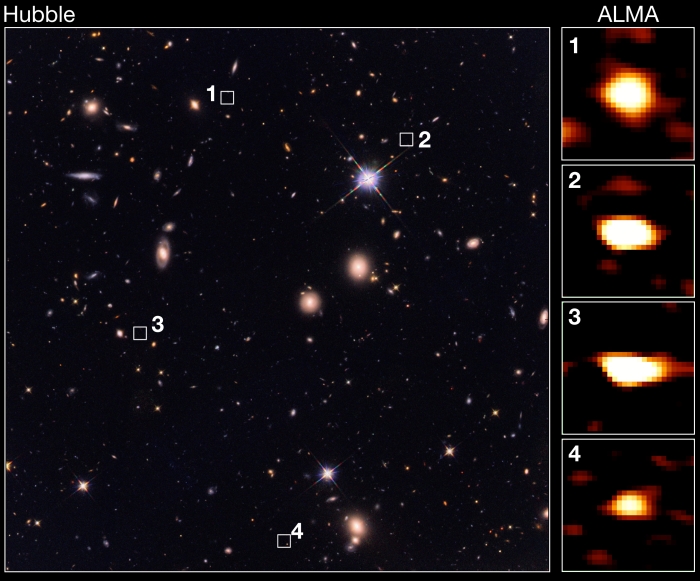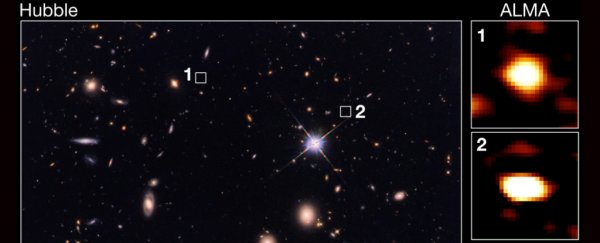You might think that huge galaxies would be hard to miss, but astronomers have just found a whole pile of them billions of light years away. Thirty-nine massive galaxies, invisible until now, are changing our understanding of the early Universe.
"This is the first time that such a large population of massive galaxies was confirmed during the first 2 billion years of the 13.7-billion-year life of the universe. These were previously invisible to us," said astronomer Tao Wang of the University of Tokyo.
"This finding contravenes current models for that period of cosmic evolution and will help to add some details, which have been missing until now."
The Universe is around 13.8 billion years old, which means - theoretically at least - we can peer into the past to see what conditions were like when the lights turned on.
Light that's 10 billion light-years away, for example, takes 10 billion years to travel across space to reach us; so, when we see something from that far away, we're seeing it as it was 10 billion years ago.
In practical terms, it's a lot more difficult. The farther light has to travel, the fainter it is when it reaches us. Think of seeing a torch at a distance of 10 metres, and at a distance of 100 metres. It's smaller and fainter at the latter distance. At 1,000 metres, you may not even be able to see it with the naked eye.
And the Universe is expanding, which stretches the light waves as they travel through space, shifting them towards the red end of the spectrum. This is called redshift, and the farther away something is, the more space is expanding between us and the object, thus increasing the redshift.
When the Hubble Space Telescope peered farther across space-time than ever before for its Deep Field series of images, it captured a broad spectrum of wavelengths, from ultraviolet to near infrared, capturing some of the most distant galaxies we've ever seen.
But these newly discovered galaxies had an additional complication.
"We detected them in the mid-infrared and submillimeter [between far-infrared and microwave] wavelength," Wang told ScienceAlert.
"These galaxies are so dark in the ultraviolet to near infrared because they contain huge amount of dust that absorbs the light at shorter wavelengths."
 Hubble Deep Field image (left) and ALMA observations in the submillimetre wavelength (right). (© 2019 Wang et al.)
Hubble Deep Field image (left) and ALMA observations in the submillimetre wavelength (right). (© 2019 Wang et al.)
At these wavelengths, it's hard to characterise these galaxies. Spectroscopy, for example, the technique used to determine the properties of stars based on a spectrum of electromagnetic radiation, becomes extremely difficult with such a limited range of wavelengths.
However, the researchers were still able to determine that these galaxies were substantial, with space density two orders of magnitude higher than extreme starburst galaxies (space density is the amount of space stuff - stars, planets and so on - packed into the space a galaxy occupies; some galaxies are more jam-packed than others).
These ancient, massive galaxies are also forming new stars at 100 times the rate of the Milky Way today.
And the more massive a galaxy, the more massive the supermassive black hole at its core. A study earlier this year showed us that these black holes are much more common in the early Universe than we previously thought, challenging our understanding of how quickly they can form.
The newly spotted galaxies are another piece of the puzzle.
"The existence of these large number of massive and dusty galaxies is unexpected in current models or simulations, which shows that the Universe can form massive systems more efficiently in the early times than we thought," Wang told ScienceAlert. "This brings new challenges to theorists and modellers."
And they also help solve another problem that had vexed astronomers: the large population of massive galaxies at low redshifts. Previous surveys of the early Universe had not found enough galaxies to explain the formation of the massive galaxies that came later.
Based on their results, the team estimated that there are a lot more of these high-redshift galaxies in lower masses that we haven't detected yet - perhaps around 530 per square degree of sky. (For perspective, the full Moon is half a degree across when viewed from Earth.)
"The large number density of this new population of massive galaxies helps to solve this tension," Wang said.
The team is planning to conduct more observations with the Atacama Large Millimeter/Submillimeter Array to try and get more detailed information about the redshift of the 39 galaxies, as well as their star formation rates and dust content.
But spectroscopic analysis of the galaxies may have to wait until after the James Webb Space Telescope, Hubble's successor, launches in 2021.
"I'm eager for upcoming observatories like the space-based James Webb Space Telescope to show us what these primordial beasts are really made of," Wang said.
The research has been published in Nature.
